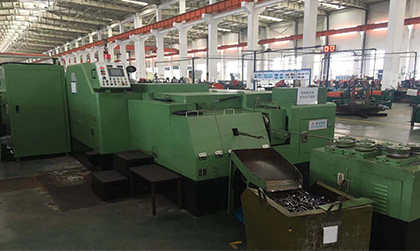Accurately measuring chain pitch is crucial for ensuring the proper functionality and longevity of your chain drive system. An incorrect chain pitch can lead to compatibility issues, premature wear, and reduced performance.
What is Chain Pitch?
What is chain pitch? Chain pitch refers to the distance between the centers of two consecutive pins or rollers in a chain. It is a critical dimension that determines the compatibility of the chain with sprockets and other mating components. Chain pitch is typically expressed in inches or millimeters, depending on the chain type and application.
Understanding chain pitch is essential when selecting a new chain or replacing an existing one. Using a chain with the incorrect pitch can result in poor fit, increased friction, and accelerated wear, ultimately leading to system failure.
How About a Chain Passing?
A chain pitch is hugely different from a chain passing. On the other hand, this refers to the clearance or space across with the chain maneuvers. It also constitutes the dimension of the chain’s path along a conveyor system or machine. This particular aspect focuses more on the physical routine and chain fitting rather than its measurement.
Tools Needed for Measuring Chain Pitch
- Vernier caliper or digital caliper
- Ruler or measuring tape
- Clean, flat surface
- Chain wear gauge (optional)
Step-By-Step Guide on How to Measure a Chain Pitch
While measuring a chain pitch looks as simple as it sounds, it requires careful planning and implementation so avoid the most common hitches. Details of the steps are below:
Step 1: Prepare Your Tools
Before getting started on how to measure a chain pitch, gather the necessary tools as enumerated earlier. Afterward, ensure the chain is clean, and free of dirt, grease and debris.
Step 2: Determine the Chain Size
As soon as you’re done with the first step, you must determine the chain size this time. Most roller chains are represented by alphanumeric codes marked on their side plates, which indicate their sizes. This code provides the most basic information about the chain pitch, as well as the roller diameter and roller width. If you are unsure about this, you can refer to the industrial chain size chart further down below. Or, check with your roller chain’s manufacturer.
Step 3: Measure the Center Distance
It is only when you have the right tools and you know the chain size well that you can start measuring. Initially, you must measure the center distance first. Determine the pitch accurately by measuring the distance between the centers of two consecutive roller chains.
Now, use your caliper to place one tip in the roller’s center before you extend the other tip to the adjacent roller’s center area. Ensure the caliper is really in contact with the roller side plate and not the pin. Note down the measurement.
Step 4: Calculate the Gap Size
By this time, you have the center distance. Refer to your notes, the divide what you have jotted down by the logarithm of the rollers, then subtract one.
For instance, if the center distance between five roller pairs is 25 mm, the pitch should be calculated this way: (25 mm ÷ 4) = 6.25 mm.
Step 5: Double-Check Your Measurements
You are almost done, but the last step is ensuring all you have are accurate. In this case, simply repeat the measurement and your calculation process, applying this at various points on your roller chain. Doing so helps rule out any inconsistency or wear in the chain pitch.
You must also note the minimum pitch measured here since this may or may not indicate excessive wear or elongation.
Confusing? Here’s a Simpler Process
If those steps seem confusing to you, there are other schools of though that offer steps in a concise outline. Here:
1. After the preparation, identify the pins or rollers on the chain. These are the cylindrical components that connect the inner and outer links of the chain.
2. Using a caliper, measure the distance between the centers of two adjacent pins. Place the caliper jaws in the centers of the pins and read the measurement on the caliper scale.
3. Write down the measured value of the chain pitch, including the unit of measurement (inches or millimeters).
4. Compare the measured chain pitch with the manufacturer’s specifications or chain data sheet.
Both those ways are generally the same, but the ways they’re presented are different. Choose according to what’s convenient for you.

Need help measuring chain pitch or choosing the right parts? Contact us today for a custom quote!
Common Mistakes to Avoid
When measuring chain pitch, be aware of the following common mistakes:
Measuring the Wrong Distance
Ensure that you are measuring the distance between the centers of the pins, not the distance between the inner or outer links.
Neglecting Chain Wear
If the chain has been in use for an extended period, it may have experienced wear. Worn chains can have elongated pitches, leading to inaccurate measurements. In such cases, using a chain wear gauge can help determine the extent of wear and whether the chain needs replacement.
Measuring Inconsistently
Measure the chain pitch at multiple points along the chain to ensure consistency. Variations in pitch can indicate uneven wear or manufacturing inconsistencies.
Disregarding Chain Cleanliness
Dirt, grease, or debris on the chain can interfere with accurate measurements. Always clean the chain before measuring the pitch.
For Optimal Performance
Measuring chain pitch accurately is vital for maintaining the performance and reliability of your chain drive system.
Visit our website to explore our range of high-quality chains and sprockets. If you need assistance measuring your chain pitch or selecting the right components for your application, our knowledgeable team is here to help. Contact us today to discuss your requirements and keep your chain drive system running smoothly.



